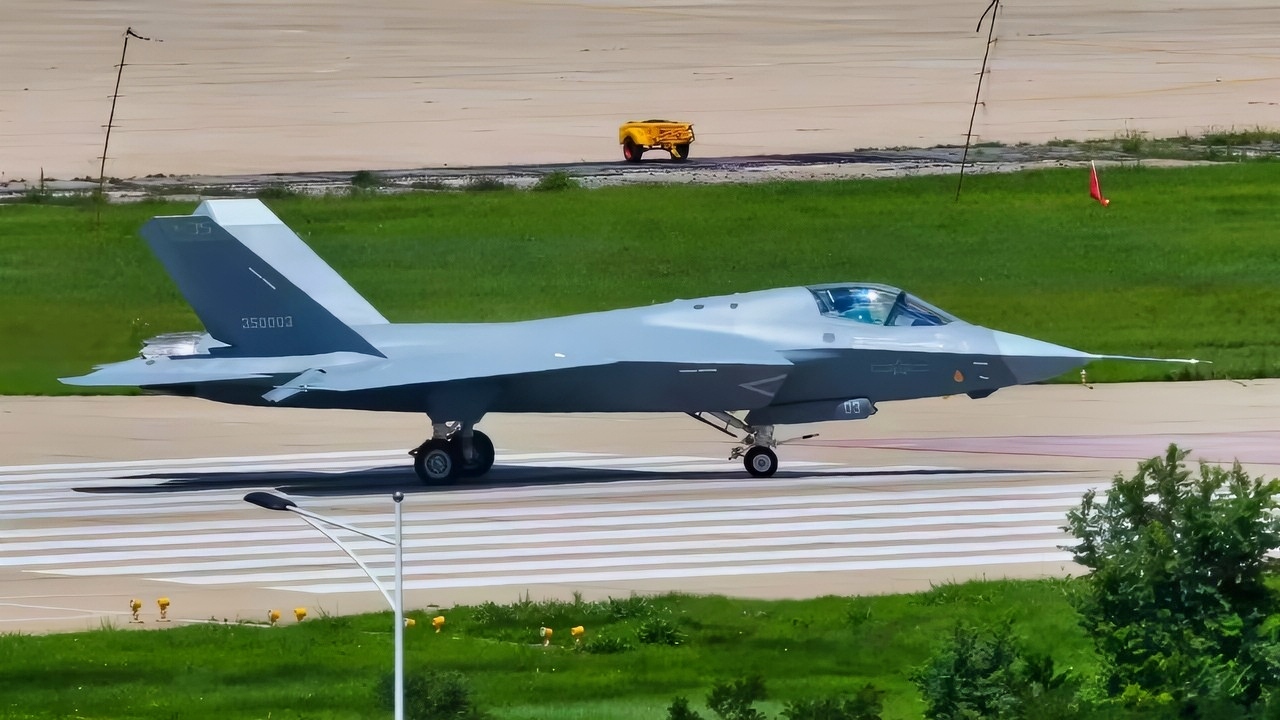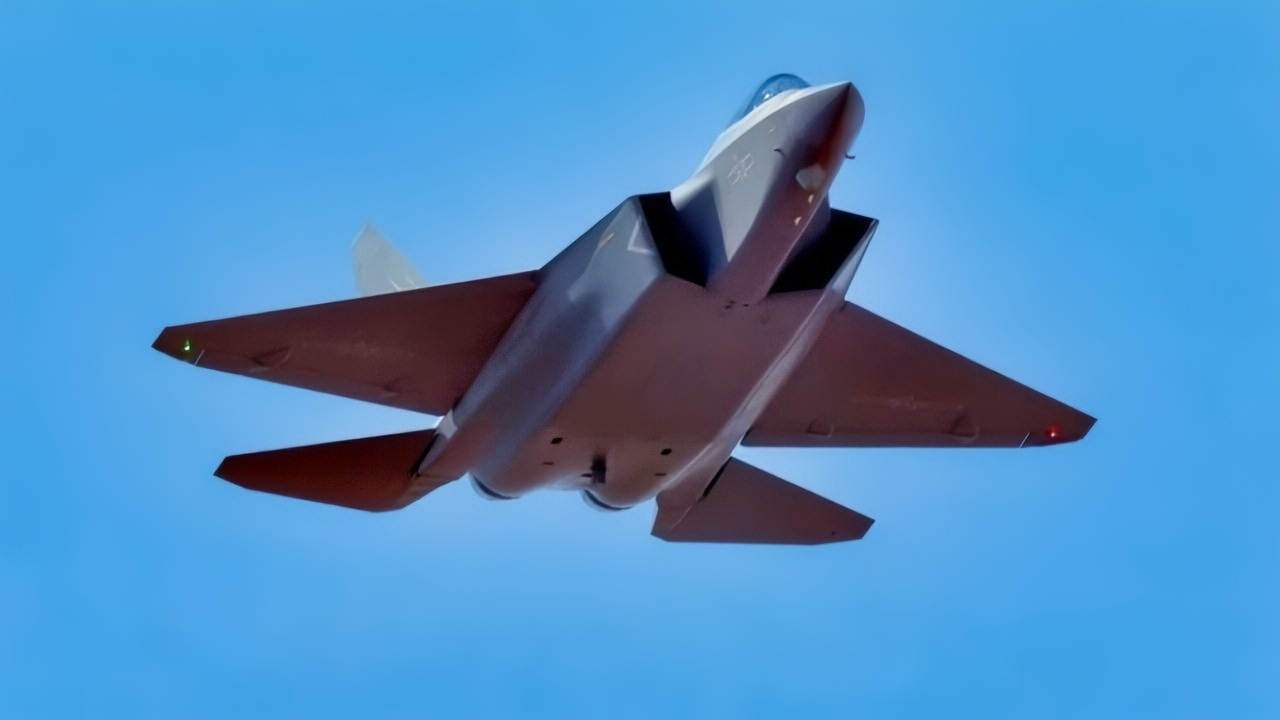Key Points and Summary – China’s J-35 borrows the F-35’s silhouette and internal bays, and it’s being tailored for carrier ops on Fujian.
-But resemblance isn’t parity. The jet’s twin-engine layout, immature coatings, and unproven avionics trail the F-35’s combat-tested stealth, sensor fusion (DAS), mission-data libraries, and allied network. The Lightning II keeps widening the gap with Block 4 upgrades while the J-35 is still in low-rate production.

J-35 Fighter X Screenshot. Image Credit: X Screen Capture.

J-35 Stealth Fighter from China. Image Credit: Creative Commons.
-Beijing will close distance over time—especially with AI-enabled software—but replicating engines, logistics, data links, and coalition interoperability will take years.
-Bottom line: the J-35 looks the part; the F-35 still owns the role.
J-35 vs. F-35: Who Wins?
China’s new stealth fighter platform, the J-35, often draws comparisons to the U.S. F-35 Lightning II—not just for its name, but also for its design, capabilities, and purpose.
They are both fifth-generation multirole jets, and both are advertised as “stealthy.”
But design similarities alone do not translate into equivalent performance.
In this instance, we know that the similarities essentially end at the naming conventions and visual cues.
Mimicking the F-35’s shape may improve the Chinese version’s stealth performance, but we know it doesn’t quite match the F-35’s.
There are, however, some critical questions for the United States and its military planners to consider. How long, for example, will it take for China to match the full spectrum of capabilities behind the F-35? And how close has China gotten in recent years?
The stakes here are high, and while we know that catching up will likely take many years—even decades- China is on its way to closing the gap with the United States.
Meet the J-35
The J-35 is officially under development by Shenyang Aircraft Corporation (SAC), a subsidiary of the state-owned Aviation Industry Corporation of China (AVIC). Originally unveiled as the FC-31 “Gyrfalcon” prototype in 2012, the design has slowly evolved into a carrier-capable fighter intended for both the People’s Liberation Army Air Force (PLAAF) and the Navy’s aviation arm (PLANAF).

J-35 Fighter from China. Image Credit: PLAAF.
On the surface, the aircraft looks similar. It has an angular fuselage, canted tail fins, and internal weapons bays that give it a silhouette strikingly identical to that of the F-35 Lightning II. But the similarities end once you get under the hood.
The J-35 uses a twin-engine layout—likely the WS-19 series—while the F-35 relies on a single Pratt & Whitney F135 engine.
Twin engines offer higher thrust, but they also add weight and complexity, which can complicate stealth maintenance and even shaping.
Like the F-35, China’s jet conceals its weapons internally to reduce radar reflections – a necessity for modern stealth – and its body uses smooth panel alignment to minimize radar section.
Yet, “stealth” is as much about manufacturing precision and radar-absorbent materials as it is about shape – and those elements remain largely unproven in China’s program. They may understand how to achieve some technical goals, but their program lags behind the United States’ multiple stealth efforts.
SAC has also adapted its design for carrier use, adding folding wings, strengthened landing gear, and catapult launch fittings, making it suitable for the new Type 003 carrier “Fujian.”
And while the aircraft is a sign that China is catching up to American capabilities, it’s worth noting that it’s still only in low-rate initial production.
Its stealth coatings, avionics, and engine reliability have not yet been tested under operational conditions—but that will soon change.
Superficial Similarities vs. Functional Gaps
The similarities between the platforms are obvious. Both jets are stealthy, but the F-35 is by far the more mature platform.
The F-35 also brings together a suite of sensors and fuses them into a single, coherent display for the pilot—a significant leap beyond previous generations. So far, though, the J-35 has yet to publicly demonstrate maturity in integrating this kind of information.
And in terms of ecosystem, logistics, and allied-network connectivity, the F-35 has the obvious lead, too.
The F-35 not only operates as a standalone jet but as part of a network of U.S. and allied systems, working with global supply chains, benefiting from upgrade pathways, and piloted by experts with decades of combat experience. The platform itself is experienced, too. Tried and tested, the F-35 beats the J-35 every day of the week – because the latter is starting from scratch.
But one of the hardest-to-replicate capabilities is what happens inside the cockpit. The F-35’s advanced sensor suite includes its Distributed Aperture System (DAS), which gives 360-degree awareness using multiple infrared sensors.
Combined with its internal sensor fusion capabilities, the aircraft’s tech ensures pilots are fully aware of their environment in ways never before possible.
China may be advancing its radar and IR sensor capabilities, but replicating decades of software development, mission data libraries, secure datalinks, and global allied integration is a much bigger challenge that will take years to complete.
In that vein, China is truly behind—and as its aviation industry tries to catch up, the U.S. continues to upgrade the F-35 under its Block 4 modernization and Technical Refresh Cycles.
In simple terms, you can build a fast car with a good engine, but turning it into a self-driving, networked vehicle that seamlessly talks to hundreds of other units is far harder. And that’s where China is today.
The J-35 looks like the F-35 and is intended to function like it, but it could be years before China reaches that goal.
And when it finally does? They’ll be thanking artificial intelligence for it.
About the Author:
Jack Buckby is a British author, counter-extremism researcher, and journalist based in New York. Reporting on the U.K., Europe, and the U.S., he works to analyze and understand left-wing and right-wing radicalization, and reports on Western governments’ approaches to the pressing issues of today. His books and research papers explore these themes and propose pragmatic solutions to our increasingly polarized society. His latest book is The Truth Teller: RFK Jr. and the Case for a Post-Partisan Presidency.
More Military
China Has the Missiles to Sink U.S. Navy Aircraft Carriers, But Questions Remain
The P-51 Mustang Was the Best WWII Fighter
The U.S. Navy’s Great Aircraft Carrier Shortage of 2025 Won’t End
The Navy Isn’t Prepared For What’s Coming
Not Made in USA: The Vanguard-Class Missile Submarine Has Just 1 Mission










